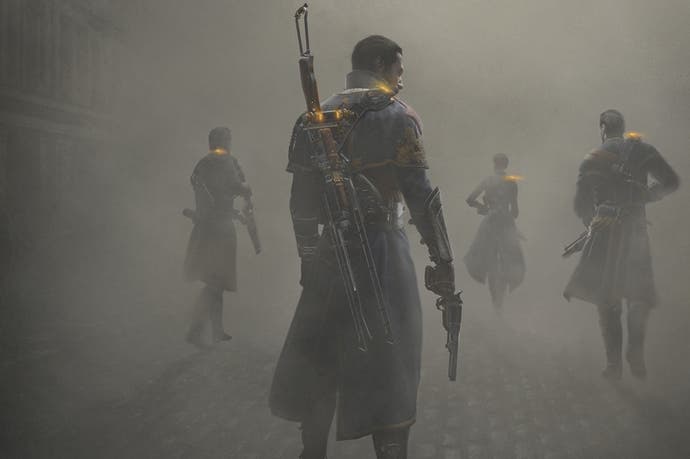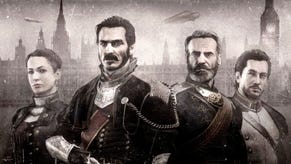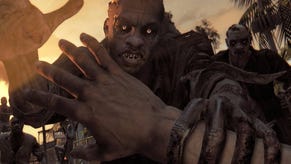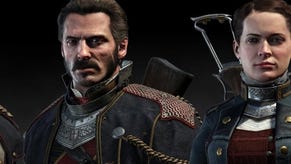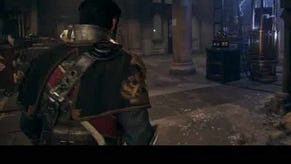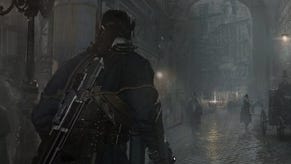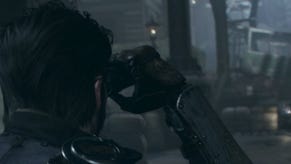How The Order reinvents QTEs and the cinematic game
The PS4 exclusive combines the methods of Quantic Dream and Naughty Dog in a triple-A spectacular.
A good few minutes of our first proper look at The Order, the PlayStation 4's high-profile, big-budget exclusive, pass before we see anything resembling traditional gameplay. Even then it's brief - a short, staged shoot-out in a crowded Whitechapel alleyway where third-person cover-based gunplay gives way to a fist fight before our hero Galahad crashes through a weak timber roof. Except it's one of those fist-fights, as Galahad's actions are brought to life via on-screen prompts that, when pressed in the correct order, see him reaching for a knife before plunging it into a rebel's neck.
This isn't a QTE, though - or, rather, that's not what developer Ready at Dawn is calling it. In their parlance it's "branching melee", whereby failure at any stage in the process simply sends you down another path. The knife isn't the only option open to Galahad, and the fight can be concluded in many more ways. All of which sounds very much like a QTE, albeit a very generous one. It seems it's not just in The Order's twisted take on Victorian history that there's been some slight revisionism and a little bending of the rules.
Since its announcement at E3 last June, a fog has existed around The Order as dense and impenetrable as the one hanging over its arcane London streets, and it's only just started to clear. The fiction has been established through brief scene-setting trailers, focussed on an alternate vision of late 19th Century England where Arthurian legend is tangled up with a dense thread of other mythologies as you take control of a secret order of heroes. It's a fiction that stretches even further back to the early days of developer Ready at Dawn; the idea began to take shape just as it had finished its first game, the PSP's Daxter.
"It started off as something else," the developer's founder and CEO Ru Weerasuriya tells us in Sony's London offices. "There was no name given to it, but it was all this amalgam of ideas that was sitting and maturing over time. And finally the gameplay started doing something, and we started bringing all of it together - and I was like, 'I've got the perfect IP for this gameplay. We've got to do this!'"
Ready at Dawn's path to triple-A development has been a curious one. It's a studio with a sound reputation, but nevertheless it's a reputation built upon a string of successful PSP spins on other people's IP. First was Daxter, a spin-off of Naughty Dog's PS2 series Jak & Daxter, followed up by Chains of Olympus and Ghost of Sparta, two outings in the God of War universe founded by Sony's Santa Monica Studio. Understandably, it wasn't long before Ready at Dawn wanted to move on to bigger things.
"In the beginning, The Order was a project - that's all it was," says Weerasuriya. "It was on PC. We didn't know what platform it was going to be on, but we knew the core mechanics. And then it obviously evolved. January 2011 was when we signed it with Sony. Rumours were going around because we were working on stuff. When we were ready to talk about it, we showed it to Sony - we said this is what our future's going to look like, and we hope it aligns with yours.
"Back then it was Allan Becker at the head of Santa Monica Studios, and Shu [Yoshida] at Worldwide. It was the perfect scenario - Shu signed our first game. It was at his office, and it was the most surreal experience. Having all of that build up to that decision and then to go, here's our future, we kind of understand you're going to PS4, and it kind of feels like everything moves together. The beauty of it is they had no problem admitting that straight away - they were like we're moving on this, you're moving on, we should try and figure out a way. And we figured out a way."
What I love about Quantic Dream is that on the emotional beat side, they're doing stuff that a lot of people wished they could do. They've achieved something in gaming that's another path. We don't all have to be the same, we have to have diversity."

The Order is not just Ready at Dawn's first crack at triple-A, then - it's also in the pressure cooker supplied by platform exclusivity. It's good pressure, Weerasuriya says, and the studio's grown from around 30 staff to a team of around 110 to help deal with it. There's something else on its side, too - the technical backing from Sony as well as a little of the expertise held by its worldwide studios as they've helped redefine the third-person shooter and mainstream narrative games across the course of the last few years.
Within seconds of seeing The Order in action, the benefits of working alongside Sony exclusively on the PlayStation 4 are clear enough. It's a fine-looking game, and one of the first to show what's really possible with the new generation of consoles. As Galahad and LaFayette, two of the four heroes that make up The Order's eponymous posse, take to a Whitechapel roof, the city stretches out across a tangible smoky horizon. Like Crytek's Ryse, a film-like visual quality is favoured over searing fidelity - which possibly explains its aim of running at 30fps over 60 - with grain and occlusion lending the image an electric authenticity. The Order's love of cinema runs deeper than the surface, too.
Of the 12 or so minutes of the game demonstration, a hefty chunk is given over to cut-scenes and exposition. Like those QTEs - or should I say "branching melees"? - there's a twist; throughout each cinematic you're given a slither of agency, with the ability to scope the landscape when Galahad looks down an eyeglass, or to examine a newly acquired weapon by rotating it in your hands.
Weerasuriya suggests that the balance in the final game will be weighted much further towards more tangible gameplay, but nevertheless it's a mix he believes is integral to the experience. "If you really think about it, it took you from a cinematic to an interactive cinematic to navigation to talk and walk, which are the moments where you navigate conversing back and forth, to gunplay to branching melee and back into cinematic," he says. "In that short moment, we're able to go on this ride while keeping the flow together. The tricky thing is you can do that and completely fail - where people don't understand what's going on. It's not 'I'm playing for 15 minutes, and I'm going to put down the controller and watch something for five minutes.' It's really about understanding that your pace is going to be built and slowed down by all these different things together."
Getting the flow right is a tricky balancing act, but at least Ready at Dawn's able to learn its lessons from one of the masters of the art. Uncharted has already been a reference point for The Order, albeit one picked out by observers rather than the developers, but nevertheless it's a comparison Weerasuriya's happy to invite. There are others still; Quantic Dream's handling of largely linear narrative seems to have bled through in the lightly interactive cut-scenes, and it's bled too into Ready at Dawn's desire to serve story above all else.

"One thing that people say about Quantic Dream is that they have their path and believe in it," says Weerasuriya. "I know they'll strive to achieve their vision, and not a lot of people have the guts to do that. You compromise and compromise too much, and when you over-compromise you lose the game you wanted to do. What I love about Quantic is that on the emotional beat side, they're doing stuff that a lot of people wished they could do. They've achieved something in gaming that's another path. We don't all have to be the same, we have to have diversity."
There's one last comparison to make. What is shown of The Order's gunplay might be brief, but in the short section of what's set to be the game's meat and potatoes it's hard not to see a slightly clunky take on a formula made famous by Epic's Gears of War before slowly dying away in recent years. Are the comparisons fair, and can a fantastical third-person shooter still be relevant in this age?
"There's some stuff in there," Weerasuriya admits. "I'm a fan of Gears. I love every game, as long as I'm getting something out of it. And Gears showed a lot of stuff about melding mechanics - it might not have invented cover, but it built on that, and of course we look at that and have fun with that. When you think about making a shooter, everybody now does cover in a similar way. So how do you do cover better? We've included soft cover and traversal. And it really does change the gameplay. Those are things that we're trying to learn from the things we love, and make it better. That's what every good studio does. They try and take something good, and make it great."
